Whitney Plantation Historic District
|
Whitney Plantation Historic District | |
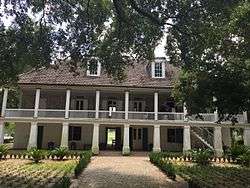 Front of the Big House | |
  | |
| Nearest city | Wallace, Louisiana |
|---|---|
| Coordinates | 30°2′21″N 90°39′2″W / 30.03917°N 90.65056°WCoordinates: 30°2′21″N 90°39′2″W / 30.03917°N 90.65056°W |
| Area | 40 acres (16 ha) |
| Built | 1803 |
| Architectural style | Federal, French Creole |
| MPS | Louisiana's French Creole Architecture MPS |
| NRHP reference # | 92001566[1] |
| Added to NRHP | November 24, 1992 |
The Whitney Plantation Historic District is a museum devoted to slavery in the Southern United States. The district, including the main house and outbuildings, is preserved near Wallace, in St. John the Baptist Parish, Louisiana, on the River Road along the Mississippi River. The plantation was started in 1752 by German immigrants Ambroise Haydel and his wife, and their descendants owned it until 1867.[2]
The museum, comprising main portions of the 2,000-acre plantation property,[2] opened its doors to the public for the first time in December 2014. It was founded by John Cummings, a trial attorney from New Orleans who has spent more than $8 million of his own fortune on this long-term project, and worked on it for nearly 15 years.[3][4] The director of research is a Senegalese scholar, Ibrahima Seck, who has done much work on the history of slavery.[2] The grounds contain imaginative exhibits and original art commissioned by Cummings, such as life-size sculptures of children to represent the former slaves who were interviewed for the Federal Writers Project book so that their stories would be told.[2]
The French Creole raised-style main house, built in 1803, is the most important architectural example in the state. In addition, the plantation has numerous extant outbuildings or "dependencies": a pigeonnier, a plantation store, the only surviving French Creole barn in Louisiana, and slave quarters (these were moved from another plantation but are typical of what was here).[5] The complex includes three archaeological sites which have had varying degrees of exploration.[6]
The 1884 Mialaret House, and its associated buildings and property, were added to the complex by later purchase. They help to reflect the long working history of the plantation.[5] Some of the extensive land is still planted in sugarcane.
The historic district was listed on the U.S. National Register of Historic Places in 1992. Whitney Plantation is also one of 26 sites featured on the Louisiana African American Heritage Trail.
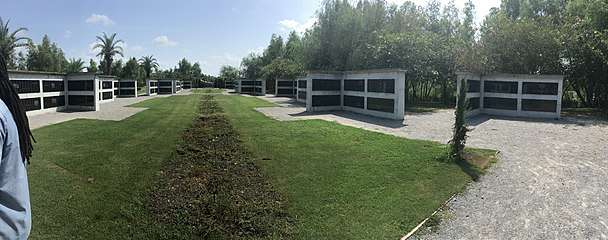 The Whitney Plantation Slave Memorials
The Whitney Plantation Slave Memorials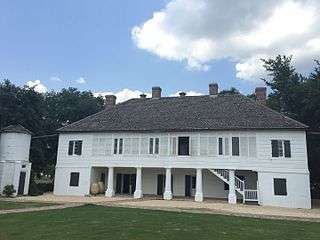 Rear of the Big House
Rear of the Big House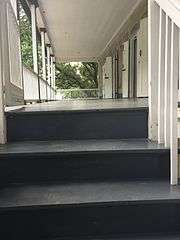 Outside gallery stairway of the Big House
Outside gallery stairway of the Big House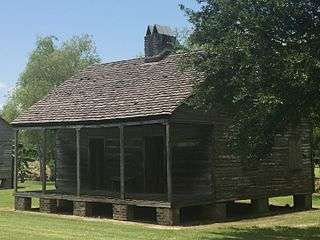 Reconstruction of blacksmith shop run by slave Robin
Reconstruction of blacksmith shop run by slave Robin
Representation in other media
- Scenes from the 2012 Quentin Tarantino film Django Unchained were filmed on and around the plantation.[3]
- The Atlantic magazine made a short documentary video about the museum, "Why America Needs a Slavery Museum" (2015).[4]
See also
References
- ↑ National Park Service (2010-07-09). "National Register Information System". National Register of Historic Places. National Park Service.
- 1 2 3 4 DAVID AMSDEN, "Building the First Slavery Museum in America", New York Times, 26 February 2015; accessed 27 October 2017
- 1 2 Kaminsky, Jonathan (17 January 2015), "Harsh world of slavery focus of Louisiana plantation museum", Reuters, accessed 2015-01-19
- 1 2 Paul Rosenfeld, "Why America Needs a Slavery Museum", 25 August 2015, The Atlantic
- 1 2 "Whitney Plantation Historic District", Southeastern Louisiana, Travel Itinerary, National Park Service, accessed 15 Jul 2008
- ↑ Nomination, "Whitney Plantation Historic District", Louisiana Office of Historic Preservation, accessed 15 Jul 2008
External links
- Official website
- "Whitney Plantation museum confronts painful history of slavery," CBS This Morning video published 08 Apr 2015.
- "Why America Needs a Slavery Museum," The Atlantic video published 27 Aug 2015.
- "Whitney Plantation Historic District," Southeastern Louisiana Travel Itinerary, National Park Service.
- Ron Stodghill, "Driving Back Into Louisiana’s History," The New York Times, 25 May 2008.
- African American Heritage Trail – LouisianaTravel.com